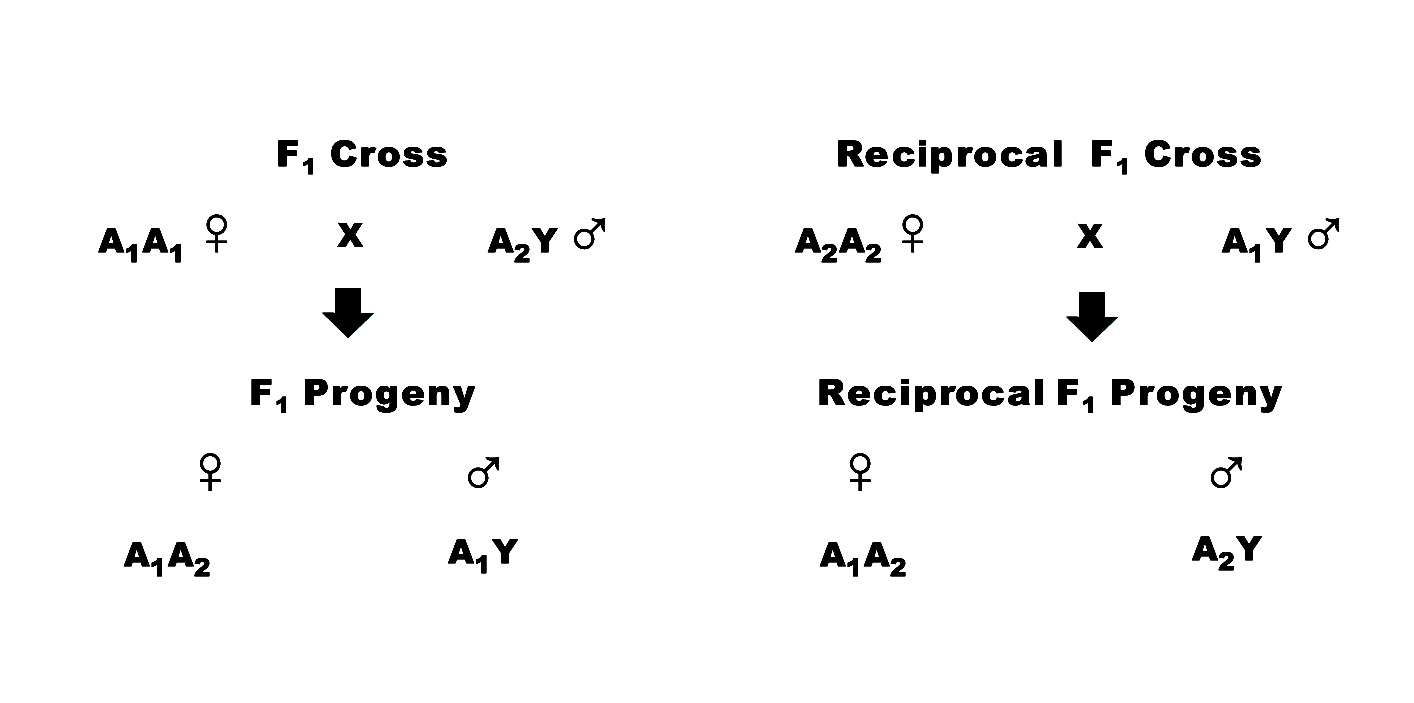|
Let A1 be the mutant allele and A2 be the wildtype allele on the X-chromosome. Let Y represent the Y-chromosome. The F1 and reciprocal F1 crosses are shown below. |
 |
Information Available from the F1 and F1 reciprocal progeny - X - Linkage
Males are the Heterogametic Sex - The XX-XY(O) System
Sex-linked traits were first described by unexpected results of F1 and reciprocal F1 crosses between a mutant white-eyed Drosophila male and a normal red-eyed Drosophila female. To explain these result, T.H. Morgan postulated that the eye color gene was on the X-chromosome.
"It now becomes evident why we found it necessary to assume a coupling of R (the eye-color gene) and X in one of the spermatozoa of the red-eyed F1 hybrid. The fact is that this R and X are combined, and have never existed apart. "
| Classic Paper - | Morgan, T. H. 1910. Sex-limited inheritance in Drosophila, Science,
32: 120-122. http://www.esp.org/foundations/genetics/classical/thm-10a.pdf |
Sex-determination is a very complex process in different species. For humans and many important model organisms (i.e., the fruit fly Drosophila melanogaster, the house mouse Mus musculus, and the nematode C. elegans) sex determination involves a special chromosome (the X-chromosome) or a special pair of heteromorphic chromosomes (the X and Y chromosomes).
In some species, females have 2 X-chromosomes and males have 1 X-chromosome. The female genotype is usually designed XX and the male genotype is XO (O = zero). In other species, the males may have a Y-chromosome (e.g., humans, mice and Drosophila). For these species, the female genotype is usually designed XX and the male genotype is XY. In humans and mice the Y-chromosome is essential for the development of "maleness" although it not important in Drosophila.
Males are called the heterogametic sex because gametes (sperm) from males differ in their chromosome sets. In humans, for example, all sperm have a complete set of 22 autosomes. In addition, half of the sperm have an X-chromosome and the other half of the sperm have a Y-chromosome. In organisms without a Y-chromosome, the sperm have either an autosome set or an autosome set plus an X-chromosome.
Females are the homogametic sex. Females produce identical gametes (at the chromosome level of organization). Each egg has a complete set of 22 autosomes and an X-chromosome.
There are other species such as the domestic chicken and the grasshopper, in which females are the heterogametic sex and males are the homogametic sex (the ZW-ZZ system). This changes the expected inheritance patterns in the F1 crosses.
| Genetics of the ZZ-ZW system |
| Classic paper | E. B. Wilson (1905) The
chromosomes in relation to the determination of sex in insects. Science,
22:500-502. Wilson describes the XX-X0 or Protenor
system as well as the XX-XY or Lygaeus system. http://www.esp.org/foundations/genetics/classical/ebw-05.pdf |
Expected F1 results for a Sex-linked (XX-XO and XX-XY) system.
If the gene is on the X-chromosome, the males of the F1 and the reciprocal F1 generations will be different.
The males from the F1 and reciprocal F1 generations will always have the phenotype of their homozygous mothers. Consequently, the males of the F1 and the reciprocal F1 generations will have different phenotypes. Males may or may not resemble their sisters, depending on dominance.
The table below summaries the patterns that you expect to see the F1 and F1 reciprocal progeny assuming sex-linked inheritance [XX-XY(O)]. The F1 cross in every case is with an unknown, homozygous or hemizygous mutant with a homozygous or hemizygous wildtype individual.
|
Let A1 be the mutant allele and A2 be the wildtype allele on the X-chromosome. Let Y represent the Y-chromosome. The F1 and reciprocal F1 crosses are shown below. |
 |
|
Dominance of Mutant Allele |
Sex-Linked XX-XY(O) |
| Recessive Phenotype |
|
| Dominant Phenotype |
|
| Incompletely Dominant Phenotype |
|
| Overdominant Phenotype |
|
| Codominant Phenotype |
|